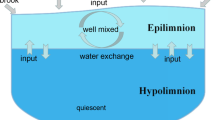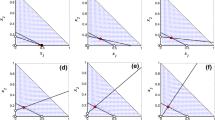Abstract
A new lower-dimension ecological–evolutionary model of algae was proposed to describe the simultaneous dynamics of variables (population biomass) and parameters (limits of the temperature tolerance interval [a – d, a + d]). In a given periodic temperature regime, the parameters tend to certain final values, which are called evolutionarily stable (ES) values. Calculations showed that ES parameters form a rainbow structure on the plane (a, d); the farthest points of the rainbow correspond to psychrophilic (diatom) and thermophilic (blue–green) algae. Algal adaptation to two periodic environmental factors, temperature and salinity, was carried out within preset temperature and salinity tolerance ranges [a – d, a + d] and [b – c, b + c]. The domain of evolutionarily stable parameters in the plane (a, b) was found to depend on the degree of synchronism of environmental factors. The parameters lay on a linear segment in some cases, while their location on a nonlinear oval was unexpectedly possible in some other cases.





Similar content being viewed by others
REFERENCES
A. M. Bronfman and E. P. Khlebnikov, The Sea of Azov: Fundamentals of Reconstruction (Gidrometeoizdat, Leningrad, 1985) [in Russian].
G. Yu. Riznichenko i A. B. Rubin, Biophysical Dynamics of Production Processes (IKI, Izhevsk, 2004) [in Russian].
A. B. Medvinskii, S. E. Petrovskii, I. A. Tikhonova, et al., Usp. Fiz. Nauk 172 (1), 31 (2002).
V. A. Kostitzin, Symbiose, parazitisme et evolution (etude mathematique) (Hermann, Paris, 1934).
V. Volterra, Mathematical Theory of the Struggle or Existence (Naika, Moscow, 1976) [in Russian].
J. B. S. Haldane, The Causes of Evolution (Longmans, Lond., 1932).
R. A. Fisher, The Genetical Theory of Natural Selection (Clarendon Press, Oxford, 1930).
V. G. Il’ichev, Stability, Adaptation, and Regulation in Ecological Systems (Fizmatlit, Moscow, 2009) [in Russian].
V. B. Verbitskii, Doctoral Dissertation in Biology (Borok, 2012).
N. N. Yakovlev, The Living and the Environment (Nauka, Leningrad, 1986) [in Russian].
Th. Dobzhansky, Genetics of the Evolutionary Process (Columbia Univ. Press, N.Y., 1970).
V. G. Il’ichev and O. A. Il’icheva, Biophysics (Moscow) 63 (2), 274 (2018).
Yu. M. Svirezhev and V. P. Pasekov, Fundamentals o Mathematical Genetics (Nauka Moscow, 1982) [in Russian].
J. M. Smith, Evolution and the Theory of Games (Cambridge Univ. Press, New York, 1982).
E. R. Pianka, Evolutionary Ecology, 2nd Ed., Harper and Row, New York, 1978; Mir, Moscow, 1981).
Yu. N. Sergeev, A. A. Kolodochka, Kh. D. Krummel, et al., Modeling the Processes of Matter Transfer and Transformation in the Sea (Leningrad, 1979) [in Russian].
B. E. Contois, J. Gen. Microbiol. 21, 40 (1959).
Yu. V. Tyutyunov and L. I. Titova, Zh. Obshch. Biol. 79 (6), 448 (2018).
W. C. Alle, A. E. Emerson, D. Park, and K. Smith, Principies of Animal Ecology (W. B. Saunders Co, Philadelphia, 1949).
V. G. Il’ichev, L. V. Dashkevich, and V. V. Kulygin, Priroda, No. 8, 54 (2019).
V. G. Il’ichev,, Avtomatika Telemekh., No. 11, 115 (1996).
V. G. Il’ichev, Biophysics (Moscow) 50 (3), 497 (2005).
V. G. Il’ichev, V. V. Kulygin, and L. V. Dashkevich, Komp’yut. Isled. Model. 9 (6), 981 (2017).
Funding
This work was supported by a state contract with the South Research Center of the Russian Academy of Sciences (project no. AAAA-A18-118122790121-5).
Author information
Authors and Affiliations
Corresponding author
Ethics declarations
Conflict of interests. The authors declare that they have no conflict of interest.
This work does not contain any studies involving animals or human subjects performed by any of the authors.
Additional information
Translated by T. Tkacheva
Abbreviations: ES, evolutionarily stable.
Rights and permissions
About this article
Cite this article
Il’ichev, V.G., Il’icheva, O.A. Hypotheses Concerning Algal Adaptation to Periodic Environmental Factors. BIOPHYSICS 66, 297–303 (2021). https://doi.org/10.1134/S0006350921020093
Received:
Revised:
Accepted:
Published:
Issue Date:
DOI: https://doi.org/10.1134/S0006350921020093




